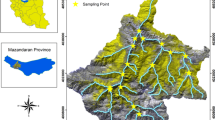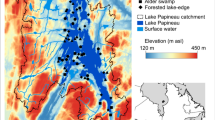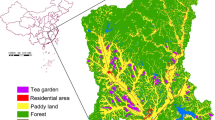Abstract
A method developed to evaluate the cumulative effect of wetland mosaics on water quality was applied to 33 lake watersheds in the seven-county region surrounding Minneapolis-St. Paul, Minnesota. A geographic information system (GIS) was used to record and measure landscape variables derived from aerial photos. Twenty-seven watershed land-use and land-cover variables were reduced to eight principal components which described 85% of the variance among watersheds. Relationships between lake water quality variables and the first six principal components plus an index of lake mixis were analyzed through stepwise multiple regression analysis. A combination of three landscape components (wetland/watershed area, agriculture/wetlands, and forest/soils components) explained 49% of the variance in a trophic state index, even though most of the lakes examined were already highly eutrophic, and thus were influenced by internal loading. The regression equations explained a range of 14 to 76% of the variation in individual water quality variables. Forested land-use was associated with lower lake trophic state, chloride, and lead. High lake trophic state was associated with agricultural land-use and with wetland distance from the lake of interest. The extent of wetlands was associated with low total lead and high color in lakes downstream. Wet meadows or herbaceous, seasonally-flooded wetlands contributed more to lake water color than did cattail marshes.
Similar content being viewed by others
References
Adamus, P.R. and Stockwell, L.R. 1983. A method for wetland functional assessment: Volume I. Critical review and evaluation concepts. U.S. Department of Transportation. Federal Highway Administration Report No. FHWA-IP-82–83. National Technical Information Service, Springfield, Virginia.
Ahern, J., Sanforth, R. and Armstrong, D.E. 1980. Phosphorus control in urban runoff by sedimentation. In Surface Water Impoundments, pp. 1012–21. Edited by H.G. Stefan. Am Soc Civil Eng.
Allot, N. 1978. Recent paleolimnology of Twin Lake near St. Paul, Minnesota, based on a transect of cores. M.S. thesis, Univ. of Minnesota.
American Public Health Association. 1936. Standard methods for the examination of water and sewage. (8th ed.). American Public Health Association, New York.
American Public Health Association. 1980. Standard methods for the examination of water and wastewater. (15th ed.). American Public Health Association, Washington, D.C.
Anderson, J.P. and Craig, W.J. 1984. Growing energy crops on Minnesota's wetlands: the land use perspective. Center for Urban and Regional Affairs, University of Minnesota, Minneapolis.
Anderson, K.L. and Scheer, B.W. 1987. A program to exchange ERDAS and EPPL7 data files. Water Resources Research Center Tech Rep 16. University of Minnesota, St. Paul, MN.
Ayers, M.A., Payne, G.A. and Have, M.R. 1980. Effects of urbanization on the water quality of lakes in Eagan, Minnesota. Water-Resources Investigations 80-71. U.S. Geological Survey.
Barr Engineering. 1971. Report to the Board of Managers, Nine Mile Creek Watershed District: Engineer's Annual Report 1970. Barr Engineering Co, Minneapolis, MN.
Barr Engineering. 1979. 1978 Lake quality inventory. Riley-Purgatory Creek Watershed District. Barr Engineering Co, Minneapolis, Minnesota. July, 1979.
Barr Engineering. 1982. 1981 Water quality inventory. Riley-Purgatory Creek Watershed District. Barr Engineering Co, Minneapolis, Minnesota.
Bayley, S.E., Zoltek, J. Jr., Hermann, A.J., Dolan, T.J. and Tortora, L. 1985. Experimental manipulation of nutrients and water in a freshwater marsh; effects on biomass, decomposition, and nutrient accumulation. Limnol Oceanogr 30: 500–512.
Bayley, S.E., Schindler, D.W. and Turner, M.A. 1987. Retention of chloride by terrestrial, wetland and lake ecosystems (abstract). American Society of Limnology and Oceanography Annual Meeting, Madison, WI. 14–18 June 1987.
Beaver, J.R. and Crisman, T.L. 1991. Importance of latitude and organic color on phytoplankton primary productivity in Florida lakes. Can. J. Fish. Aquat. Sci. 48: 1145–1150.
Bernard, J.M. and Gorham, E. 1978. Life history aspects of primary production in sedge wetlands. In Freshwater Wetlands: Ecological Processes and Management Potential, pp. 39–51. Edited by R.E. Good, D.F. Whigham and R.L. Simpson. Academic Press, New York.
Bowden, W.B. 1987. The biogeochemistry of nitrogen in freshwater wetlands. Biogeochemistry 4: 313-348.
Bradbury, J.P. 1975. Diatom stratigraphy and human settlement in Minnesota. Geol Soc Am Spec Pap 171: 1–74.
Brown, R.G. 1985. Effects of wetlands on quality of runoff entering lakes in the Twin Cities metropolitan area, Minnesota. U.S. Geological Survey, Water-Resources Investigations Report 85-4170.
Canfield, D.E. Jr. and Bachmann, R.W. 1981. Prediction of total phosphorus concentrations, chlorophyll a, and Secchi depths in natural and artificial lakes. Can J Fish Aquat Sci 38: 414–423.
Carpenter, S.R., Kitchell, J.F. and Hodgson, J.R. 1985. Cascading trophic interactions and lake productivity. Bioscience 35: 634–639.
Chesters, G., Robinson, J., Strefel, R., Ostry, R., Bahr, T., Cootl, D.R. and Whitt, D.M. 1978. Pilot watershed studies. Summary report. International Joint Commission, Windsor, Ontario.
Cooper, J.R., Gilliam, J.W. and Jacobs, T.C. 1986. Riparian areas as a control of nonpoint pollutants. In Watershed Research Perspectives. pp. 166–192. Edited by D.L. Correll. Smithsonian Institution Press. Washington, D.C.
Cowardin, L.M., Carter, V., Golet, F.C. and LaRoe, E.T. 1979. Classification of wetlands and deepwater habitats of the United States. Biological Services Program, U.S. Fish and Wildlife Service. FWS/OBS-79/31.
Davis, C.B. and van der Valk, A.G. 1978. Litter decomposition in prairie glacial marshes. In Freshwater Wetlands, pp. 99–113. Edited by R.E. Good, D.F. Whigham and R.L. Simpson. Academic Press, New York.
Detenbeck, N.E., Johnston, C.A. and Niemi, G.J. 1991. Use of geographic information systems to assess the effect of wetlands on lake water quality in the Minneapolis/St. Paul metropolitan area. In Proceedings of the Second Annual Minnesota Lake Management Conference pp. 81–86. Brainerd, MN. October 7–9, 1990.
Dillon, P.J. and Rigler, F.H. 1974. The phosphorus-chlorophyll relationship in lakes. Limnol Oceanogr 19: 767–773.
Draper, N.R. and Smith, H. 1981. Applied regression analysis (2nd ed.). John Wiley and Sons, NY.
Engstrom, D.R. and Swain, E.B. 1986. The chemistry of lake sediments in time and space. Hydrobiologia 143: 37–44.
Environmental Protection Agency. 1980. Water quality criteria documents; availability. Federal Register. November 28, 1980. 45(231): 79318–79379.
Giblin, A.E. 1985. Comparison of processing of elements by ecosystems. II. Metals. In Ecological Considerations in Wetlands Treatment of Municipal Wastewater. pp. 158–179. Edited by P.J. Godfrey, E.R. Kaynor, S. Pelczarski and J. Benforado. Van Nostrand Reinhold, NY.
Gilliam, J.W., Skaggs, R.W. and Doty, C.W. 1986. Controlled agricultural drainage: an alternative to riparian vegetation. In Watershed Research Perspectives. pp. 225–243. Edited by D.L. Correll. Smithsonian Institution Press. Washington, D.C.
Gorham, E., Dean, W.E. and Sanger, J.E. 1983. The chemical composition of lakes in the north-central United States. Limnol Oceanogr 28: 287–301.
Gorham, E., Underwood, J.K., Martin, F.B. and Ogden, J.G. III. 1986. Natural and anthropogenic causes of lake acidification in Nova Scotia. Nature 324: 451–453.
Gustafson, T.D. 1976. Production, photosynthesis and storage and utilization of reserves in a natural stand of Typha latifolia L. (Ph.D. Thesis. University of Wisconsin-Madison, Wisconsin).
Hickok, E.A. and Associates. 1980. Hydrologic data report, 1979: Minnehaha Creek Watershed District. E.A. Hickok and Associates, Wayzata, MN.
Horner, R.R. 1988. Long term effects of urban stormwater on wetlands. In Proceedings of an Engineering Foundation Conference on Current Practice and Design Criteria for Urban Quality Control, July 10–15, 1988, Potosi, Missouri, pp. 452–465. American Society of Civil Engineers.
Johnson, R.A. and Wichern, D.W. 1982. Applied multivariate statistical analysis. Prentice-Hall, Inc., Englewood Cliffs, N.J.
Johnston, C.A., Detenbeck, N.E., Bonde, J.P. and Niemi, G.J. 1988. Geographic information systems for cumulative impact assessment. Photogrammetric Engineering and Remote Sensing 54: 1609–1615.
Johnston, C.A., Detenbeck, N.E. and Niemi, G.J. 1990. The cumulative effect of wetlands on stream water quality and quantity: A landscape approach. Biogeochemistry 10: 105–141.
Kowalczewski, A. 1978. Importance of a bordering wetland for chemical properties of lake water. Verh Internat Verein Limnol 20: 2182–2185.
Lie, G.B. 1977. Aspects of the ecology and physiology of freshwater macrophytes: Phosphorus cycling by freshwater macrophytes - the case of Shagawa Lake. (Ph.D. thesis, University of Minnesota, Minneapolis, MN).
Mason, C.F. and Bryant, R.J. 1975. Production, nutrient content and decomposition of Phragmites communis Trin. and Typha angustifolia L. J. Ecology 63: 71–95.
McBride, M.S. 1976. Hydrology of lakes in the Minneapolis-Saint Paul Metropolitan Area: A summary of available data stored - using a data-base management system. U.S. Geological Survey. Water-Resources Investigations 76–85.
McKnight, D., Thurman, E.M., Wershaw, R.L. and Hemond, H.F. 1985. Biogeochemistry of aquatic humic substances in Thoreau's Bog, Concord, Massachusetts. Ecology 66: 1339–1352.
Metropolitan Council. 1981. A 1980 study of the water quality of 60 lakes in the Twin Cities Metropolitan Area. Publication 01–81–047. Metropolitan Council, St. Paul, MN. June 1981.
Metropolitan Council. 1982. A 1981 study of the water quality of 30 lakes in the seven-county Metropolitan Area. Publication 10–82–005. Metropolitan Council, St. Paul, MN. March 1982.
Metropolitan Council. 1984. A 1984 study of the water quality of 43 Metropolitan Area lakes. Publication 10–84–172. Metropolitan Council, St. Paul, MN. December 1984.
Minnesota Pollution Control Agency. 1985. Report on the transparency of Minnesota lakes: Citizen Lake Monitoring Program. MN Pollution Control Agency, St. Paul, MN.
Minnesota Pollution Control Agency. 1988. Minnesota lakes and streams: A compilation of analytical data from the routine water quality monitoring program. Vol. 13. October 1984–September 1987. MN Pollution Control Agency. Division of Water Quality. St. Paul, MN.
Minnesota Soil Atlas. Stillwater Sheet. 1980. Misc. Rept. 171–1980. Agr. Exp. Station. Univ of MN, St. Paul, MN.
Minnesota Soil Atlas. St. Paul Sheet. 1973. Misc. Rept. 120–1973. Agr. Exp. Station. Univ of MN, St. Paul, MN.
Minnesota State Planning Agency. 1987. EPPL7 User's Guide. Land Management Information Center, St. Paul, MN.
Moyle, J.B. 1954. Some aspects of the chemistry of Minnesota surface waters and wildlife management. J Wildl Manage 20: 303–320.
Norusis, M.J. 1988. SPSS/PC + for the IBM PC/XT/AT. SPSS, Inc., Chicago, IL.
Novitzki, R.P. 1979. Hydrologic characteristics of Wisconsin's wetlands and their influence on floods, stream flow, and sediment. In Wetland functions and values: the state of our understanding, pp. 377–388. Edited by P.E. Greeson, J.R. Clark and J.E. Clark. Proc. Nat. Symp. on Wetlands, Lake Buena Vista, FL. Amer. Water Resources Assoc., Minneapolis, MN.
Novotny, V. and Chesters, G. 1981. Handbook of nonpoint pollution: Sources and management. Environmental Engineering Series. Van Nostrand Reinhold, New York, NY.
Oberts, G.L. 1981. Impact of wetlands on watershed water quality. In Selected Proceedings of the Midwest Conference on Wetland Values and Management, pp. 213–226. Edited by B. Richardson. Minnesota Water Planning Board, St. Paul.
Oberts, G.L. and Jouseau, M. 1979. Water pollution from nonpoint sources: An assessment and recommendations. Metropolitan Council of the Twin Cities Area Publication No 62-72-008.
Omernik, J.M. 1976. The influence of land use on stream nutrient levels. EPA-600–76–014. U.S. EPA, Corvallis, Oregon.
Orion Research, Inc. 1973. Analytical methods guide. 6th edition.
Osborne, L.L. and Wiley, M.J. 1988. Empirical relationships between land use/cover and stream water quality in an agricultural watershed. J. Environ. Mgmt. 26: 9–27.
Osgood, R. 1988. Lake mixis and internal phosphorus dynamics. Arch. Hydrobiol. 113: 629–638.
Owens, T. and Meyer, M. 1978. A wetland survey of the Twin Cities 7-county metropolitan area - East half. IAFHE FSL Research Report 78–2. University of Minnesota, St. Paul, MN.
Paloheimo, J.E. and Zimmerman, A.P. 1983. Factors influencing phosphorus-phytoplankton relationships. Can. J. Fish. Aquat. Sci. 40: 1804–1812.
Peterjohn, W.T. and Correll, D.L. 1984. Nutrient dynamics in an agricultural watershed: Observations of the role of a riparian forest. Ecology 65: 1466–1475.
Prentki, R.T., Gustafson, T.D. and Adams, M.S. 1978. Nutrient movements in lakeshore marshes. In Freshwater Wetlands: Ecological Processes and Management Potential. pp. 169–194. Edited by R.E. Good, D.F. Whigham, R.L. Simpson and C.G. Jackson Jr., Academic Press, New York.
Prochazkova, L., Blazka, P. and Brandl, Z. 1983. The output of NO3-N and other elements from small homogeneous watersheds. In Programme on Man and Biosphere Project 5 Workshop: Land use impacts on aquatic systems. pp. 291-306. Edited by G. Jolankai and G. Roberts. Budapest, Hungary, October 1983.
Ramsey County Environmental Services. 1981. Water quality of lakes in Ramsey County, 1980. Ramsey County, MN.
Richards, F.A. and Kletsch, R.A. 1964. The spectrophotometric determination of ammonia and labile amino compounds in fresh and seawater by oxidation to nitrate. In Recent Researches in the Fields of Hydrosphere, Atmosphere, and Nuclear Geochemistry. pp. 65–81. Edited by Y. Miyake and T. Keyama.
Richardson, C.J. 1985. Mechanisms controlling phosphorus retention capacity in freshwater wetlands. Science 228: 1424–1427.
Richardson, C.J. and Nichols, C.S. 1985. Ecological analysis of wastewater management criteria in wetland ecosystems. In Ecological considerations in wetlands treatment of municipal wastewaters. pp. 351–391. Edited by P.J. Godfrey, E.R. Kaynor, S. Pelczarski and J. Benforado. Von Nostrand Reinhold Company, New York.
Sager, P.E., Richman, S., Harris, H.J. and Fewless, G. 1985. Preliminary observations on the flux of carbon, nitrogen, and phosphorus in a Great Lakes coastal marsh. In Coastal Wetlands. pp. 59–65. Edited by H.H. Prince and P.M. d'Itri. Lewis Publishers, Inc. Chelsea, MI.
Schindler, D.W. 1971. A hypothesis to explain differences and similarities among lakes in the Experimental Lakes Area, Northwestern Ontario. J Fish Res Board Can 28: 295–301.
Stockdale, E.C. 1991. Freshwater wetlands, urban stormwater, and nonpoint source pollution control: A literature review and annotated bibliography. Washington State Department of Ecology. 267 pages.
Snedecor, G.W. and Cochran, W.G. 1980. Statistical Methods. 7th ed. Iowa State Univ. Press: Ames, Iowa. 507 pages.
STATISTIX. 1987. STATISTIX: An interactive statistical program for microcomputers. NH Analytical Software, St. Paul, MN.
Tatsuoka, M.M. 1971. Multivariate analysis: Techniques for educational and psychological research. John Wiley & Sons, Inc., New York.
Tiner, R.W. Jr. 1984. Wetlands of the United States: current status and recent trends. U.S. Department of the Interior, Fish and Wildlife Service, Washington, D.C.
U.S. Environmental Protection Agency. 1973. Biological field and laboratory methods. EPA 670/4-73-001.
U.S. Environmental Protection Agency. 1979. Methods of chemical analyses of water and wastes. Office of Technology Transfer. March 1979.
van der Valk, A.G., Davis, C.B., Baker, J.L. and Beer, C.E. 1978. Natural fresh water wetlands as nitrogen and phosphorus traps for land runoff. In Wetland Functions and Values: The State of our Understanding, pp. 457–467. Edited by P.E. Greeson, J.R. Clark and J.E. Clark. American Water Resources Association, Proc. Nat. Symp. on Wetlands, Lake Buena Vista, FL. Amer. Water Resources Assoc., Minneapolis, MN.
Vollenweider, R.A. 1968. Scientific fundamentals of the eutrophication of lakes and flowing waters, with particular reference to nitrogen and phosphorus as factors in eutrophication. Org Econ Coop Dev Tech Rep DAS/CS1/68.27.
Walker, W. Jr. 1987. Phosphorus removal by urban runoff detention basins. Lake and Reservoir Manage 3: 314–326.
Wetzel, R. 1983. Limnology. W.B. Saunders Company: Philadelphia. 743 pages.
Whigham, D.F. and Chitterling, C. 1988. Impacts of freshwater wetlands on water quality a landscape perspective. J Environ Manage 12: 663–674.
Wright, D.J. and Shapiro, J. 1984. Nutrient reduction by biomanipulation: An unexpected phenomenon and its possible causes. Verh Internat Verein Limnol 22: 518–524.
Young, R.A., Onstad, C.A., Bosch, D.D. and Anderson, W.P. 1989. AGNPS: A nonpoint-source pollution model for evaluating agricultural watersheds. J Soil Water Conservation 44(2): 168–173.
Zimmerman, A.P., Nobel, K.M., Gates, M.A. and Paloheimo, J.E. 1983. Physico-chemical typologies of south-central Ontario lakes. Can. J. Fish. Aquat. Sci. 40: 1788–1803.
Author information
Authors and Affiliations
Rights and permissions
About this article
Cite this article
Detenbeck, N.E., Johnston, C.A. & Niemi, G.J. Wetland effects on lake water quality in the Minneapolis/St. Paul metropolitan area. Landscape Ecol 8, 39–61 (1993). https://doi.org/10.1007/BF00129866
Issue Date:
DOI: https://doi.org/10.1007/BF00129866




